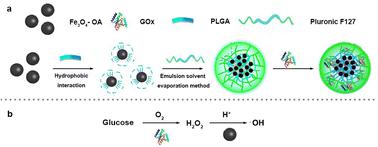Our official English website, www.x-mol.net, welcomes your
feedback! (Note: you will need to create a separate account there.)
Degradable Fe3O4-based nanocomposite for cascade reaction-enhanced anti-tumor therapy
RSC Advances ( IF 3.9 ) Pub Date : 2023-03-09 , DOI: 10.1039/d3ra00527e
Yang Wang 1 , Xun Li 2 , Yuan Fang 1 , Jianhua Wang 1 , Danhong Yan 1 , Baisong Chang 2
RSC Advances ( IF 3.9 ) Pub Date : 2023-03-09 , DOI: 10.1039/d3ra00527e
Yang Wang 1 , Xun Li 2 , Yuan Fang 1 , Jianhua Wang 1 , Danhong Yan 1 , Baisong Chang 2
Affiliation

|
Cascade catalytic therapy has been recognized as a promising cancer treatment strategy, which is due in part to the induced tumor apoptosis when converting intratumoral hydrogen peroxide (H2O2) into highly toxic hydroxyl radicals (˙OH) based on the Fenton or Fenton-like reactions. Moreover this is driven by the efficient catalysis of glucose oxidization associated with starving therapy. The natural glucose oxidase (GOx), recognized as a “star” enzyme catalyst involved in cancer treatment, can specially and efficiently catalyze the glucose oxidization into gluconic acid and H2O2. Herein, pH-responsive biodegradable cascade therapeutic nanocomposites (Fe3O4/GOx–PLGA) with dual enzymatic catalytic features were designed to respond to the tumor microenvironment (TME) and to catalyze the cascade reaction (glucose oxidation and Fenton-like reaction) for inducing oxidase stress. The GOx-motivated oxidation reaction could effectively consume intratumoral glucose to produce H2O2 for starvation therapy and the enriched H2O2 was subsequently converted into highly toxic ˙OH by a Fe3O4-mediated Fenton-like reaction for chemodynamic therapy (CDT). In addition, the acidity amplification owing to the generation of gluconic acid will in turn accelerate the degradation of the nanocomposite and initiate the Fe3O4–H2O2 reaction for enhancing CDT. The resultant cooperative cancer therapy was proven to provide highly efficient tumor inhibition on HeLa cells with minimal systemic toxicity. This cascade catalytic Fenton nanocomposite might provide a promising strategy for efficient cancer therapy.
中文翻译:

用于级联反应增强抗肿瘤治疗的可降解 Fe3O4 基纳米复合材料
级联催化疗法已被认为是一种有前途的癌症治疗策略,部分原因是基于芬顿或芬顿-将肿瘤内过氧化氢(H 2 O 2 )转化为剧毒羟基自由基(˙OH)时诱导肿瘤细胞凋亡。像反应。此外,这是由与饥饿疗法相关的葡萄糖氧化的有效催化驱动的。天然葡萄糖氧化酶(GO x )被认为是癌症治疗中的“明星”酶催化剂,可以特异性、高效地催化葡萄糖氧化成葡萄糖酸和H 2 O 2 。本文设计了具有双酶催化特性的pH响应性可生物降解级联治疗纳米复合材料(Fe 3 O 4 /GO x –PLGA),以响应肿瘤微环境(TME)并催化级联反应(葡萄糖氧化和类芬顿反应) )用于诱导氧化酶应激。 GO x驱动的氧化反应可以有效消耗瘤内葡萄糖产生 H 2 O 2用于饥饿治疗,富集的 H 2 O 2随后通过 Fe 3 O 4介导的类 Fenton 反应转化为剧毒的 ˙OH 用于化学动力学治疗(CDT)。 此外,由于葡萄糖酸的产生而导致的酸度放大反过来会加速纳米复合材料的降解并引发Fe 3 O 4 -H 2 O 2反应以增强CDT。由此产生的协同癌症疗法被证明可以对 HeLa 细胞提供高效的肿瘤抑制作用,并且全身毒性最小。这种级联催化芬顿纳米复合材料可能为有效的癌症治疗提供一种有前景的策略。
更新日期:2023-03-09
中文翻译:

用于级联反应增强抗肿瘤治疗的可降解 Fe3O4 基纳米复合材料
级联催化疗法已被认为是一种有前途的癌症治疗策略,部分原因是基于芬顿或芬顿-将肿瘤内过氧化氢(H 2 O 2 )转化为剧毒羟基自由基(˙OH)时诱导肿瘤细胞凋亡。像反应。此外,这是由与饥饿疗法相关的葡萄糖氧化的有效催化驱动的。天然葡萄糖氧化酶(GO x )被认为是癌症治疗中的“明星”酶催化剂,可以特异性、高效地催化葡萄糖氧化成葡萄糖酸和H 2 O 2 。本文设计了具有双酶催化特性的pH响应性可生物降解级联治疗纳米复合材料(Fe 3 O 4 /GO x –PLGA),以响应肿瘤微环境(TME)并催化级联反应(葡萄糖氧化和类芬顿反应) )用于诱导氧化酶应激。 GO x驱动的氧化反应可以有效消耗瘤内葡萄糖产生 H 2 O 2用于饥饿治疗,富集的 H 2 O 2随后通过 Fe 3 O 4介导的类 Fenton 反应转化为剧毒的 ˙OH 用于化学动力学治疗(CDT)。 此外,由于葡萄糖酸的产生而导致的酸度放大反过来会加速纳米复合材料的降解并引发Fe 3 O 4 -H 2 O 2反应以增强CDT。由此产生的协同癌症疗法被证明可以对 HeLa 细胞提供高效的肿瘤抑制作用,并且全身毒性最小。这种级联催化芬顿纳米复合材料可能为有效的癌症治疗提供一种有前景的策略。

































 京公网安备 11010802027423号
京公网安备 11010802027423号